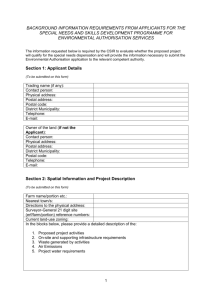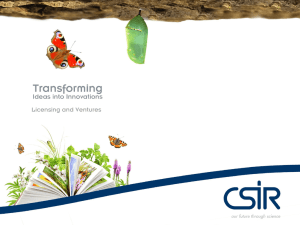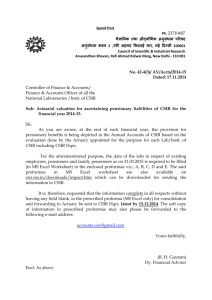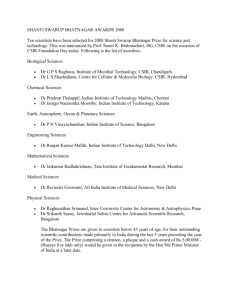Intellectual Property Management Division Council of Scientific
advertisement
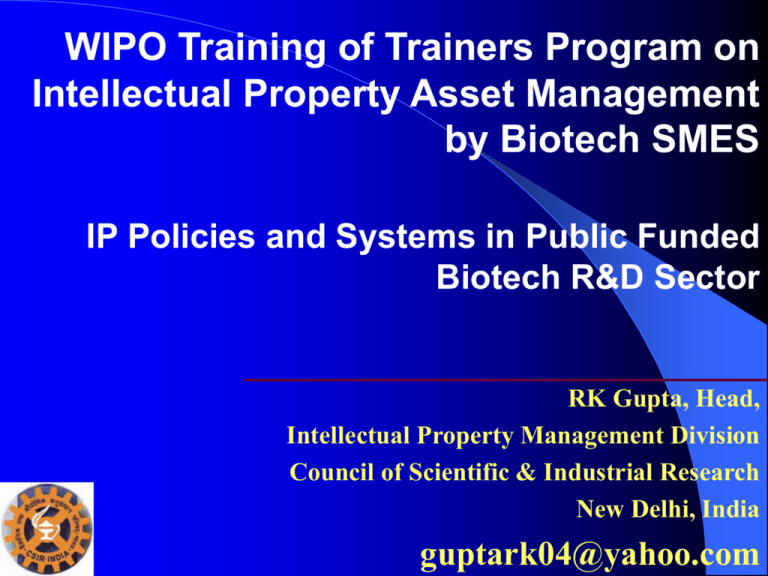
WIPO Training of Trainers Program on Intellectual Property Asset Management by Biotech SMES IP Policies and Systems in Public Funded Biotech R&D Sector RK Gupta, Head, Intellectual Property Management Division Council of Scientific & Industrial Research New Delhi, India guptark04@yahoo.com Evolution of IP Policy of Scientific Research Institutions of India 1995-2010 Scientific and Industrial Research Institutions Mandate Research Teaching Focus on select areas to meet national economic & strategic requirements IMPACT of R&D Output (Patents/Publications) Capacity building Alternate process/ products development Development of technology in case of denials Control of price of competing products Employment generation Growth of New businesses Revenue generation Benefit sharing Development of industrial clusters around R&D institutes Technology Transfer/ spill-overs Initial Objectives of IP Policies of Scientific and Industrial Research Institutions To create massive awareness programs among scientists, students and faculty To capture IP from ongoing R&D projects To identify new problems To protect R&D output through appropriate IP protection nationally and internationally Objectives of IP Policies of Scientific and Industrial Research Institutions CSIR-1996 ICMR-2002 ICAR-2006 To create IPR awareness To work for societal benefit To safeguard public health To facilitate capture and protection of IP at early stages before publication of research results, where applicable To facilitate recordal of lab data To obtain “Invention Disclosures” form from scientists To form linkages between IP cells of labs and central IP departments To handle IP ownership issues To valorise IP through various mechanisms To facilitate sharing of royalties with scientists Focus of IP Protection in Scientific and Industrial Institutions Patents Copyrights ***** *** Plant varieties Layout design for integrated circuits Trademarks Industrial design Geographical indication **** * * ** * Ownership of IP Scientific departments Scientists Funding agencies Sponsors Collaborators (Indian as well as foreign research institutions/universities) Governmental authorities (like NBA) IP in contracts, PPPs & International Agreements Governmental rights Valorisation of IP Licensing (exclusive, non-exclusive, limited exclusive, royalty free, equity) Assignment / sale Spin-offs and start ups Co-Development Benefit sharing Scientific Departments Researchers Technical staff Technology Transfer Cells IP Policies of Scientific & Industrial Research Institutions-Current Status IP Policy Components Remarks Vision/Mission stated Implementing authority centralized/decentralized/hybrid Ownership of various firms of IP need for a flexible policy Use of significant resources of the institutions not clear in many cases Assessment of IP need for improvement Invention Disclosure and assignment of rights existing Protection of IP in Foreign Countries need for a dynamic policy Maintenance of IP rights need for a better understanding Material Transfer Agreement better understanding needed/application of NBA/BDA Rules Sharing of Earnings provisions existing, implementation difficult in several cases Conflict of interest need for better understanding Publication Policy clear Setting up of IP cells established/need for further strengthening Issues Cost of IP protection Societal concerns Managing IP in sponsored research/collaborations Problems in sharing IP in International collaborations Monitoring and Implementation of IP in agreements Absence of linkages between IP and development policies IP valuation and licensing Formation of Spin-off and Start up companies IP in acquisition and mergers. Biological Material Transfer Issues and National legislations IP enforcement issues Open source initiatives with global partnerships Worldwide technology transfer Centers being unprofitable FTO IP Management Policy of CSIR & its Implementation – A Case Study Council of Scientific & Industrial Research, India CSIR The largest network of publicly funded Research Labs in the world 17000 highly qualified Scientists, Engineers, Auxiliary staff Annual Budget about Rupees 1450 Crores aprox. R&D in Aerospace, Biological Sciences, Chemicals, Pharmaceuticals, Drugs, Earth Resources, Food, construction, minerals, metals, environment, leather, information products etc. Council of Scientific & Industrial Research, India CSIR Mission “To provide scientific industrial R&D that maximizes the economic, environmental & societal benefits for the people of India” Serve the Nation IP Management in CSIR - Genesis Patenting activity in CSIR - instituted since its very inception and looked after by its Patent Cell at CSIR HQ. (few patent filings) Enactment of Patents Act, 1970 - the Patent Cell upgraded to the Patents Unit. (Sporadic filings) India joins WTO in 1995 – the Patents Unit upgraded as a Division named Intellectual Property Management Division (IPMD) in 1995 Post -1995 : Boost to patenting of drugs, pharmaceuticals and bio-tech inventions CSIR’s IP Policy (1996) : Meeting Post-WTO Challenges Statement of the IP Policy “The maximization of the benefits to CSIR from its intellectual property by stimulating higher levels of innovation through a judicious system of rewards, ensuring timely and effective legal protection for its IP and leveraging and forging strategies alliances for enhancing the value of its IP.” CSIR Targets (Vision 2001) Portfolio of 500 foreign patents (then 80 in 1996) Portfolio of 1000 Indian patents (then 436 in 1996) Meeting post WTO challenges Goals of the IP Policy stimulate and encourage increased creativity and innovation in CSIR to gain economic advantage; develop skills amongst the scientists to understand, interpret and analyze the techno-legal and business information contained in patents and other IP documents; use the information acquired from analysis of IP documents to direct and mount strategic R&D programmes; establish a globally acceptable system of recording and documentation of experimental results and data; evolve appropriate systems to capture and assess the intellectual property generated in the CSI R system; provide the highest level of professional techno-legal services for securing and protecting the IP generated; manage the portfolio of IP as a business activity; manipu1ate the patent portfolio, defensively / and aggressively, to forge strategic alliances / international S&T collaborations, to gain business advantage / and ward of competition; Institutionalization of IP Management Structure in CSIR DG, CSIR IP management structure in CSIR CSIR LABS IPMD Slogan 1996~Patent and publish 1998~Patent, publish and prosper Capacity Building (1995-2010) IP Management Information & Documentation Patent Search & Analysis Techno-Legal Drafting Patent Litigation Licensing, Valuation and negotiating IP licensing deals Patent Portfolio Development Expansion of Patent Coverage (Improvement Patents) Protection of New Uses/Combinations Creation of Buffer Zone Surrounding Patents Performance of CSIR CSIR Patent filing 1000 921 915 900 761 800 719 669 663 700 605 600 500 400 300 377 409 413 421 405 415 407 404 262 170 200 261 207 183 100 0 1999-00 2000-01 2001-02 2002-03 2003-04 India 2004-05 2005-06 Foreign 2006-07 2007-08 2008-09 CSIR Patents Granted Abroad 364 400 339 350 300 300 319 244 218 250 191 200 150 100 94 62 50 0 2000- 2001- 2002- 2003- 2004- 2005- 2006- 2007- 200801 02 03 04 05 06 07 08 09 CSIR Patents Granted in India 800 700 703 600 500 400 341 300 276 200 100 399 112 117 162 278 281 175 0 1999- 2000- 2001- 2002- 2003- 2004- 2005- 2006- 2007- 200800 01 02 03 04 05 06 07 08 09 CSIR Patent Applications filed in foreign countries 1000 900 800 700 600 500 400 300 200 100 0 921 915 605 262 663 669 719 Deliberate intervention to focus on commercially and strategically important inventions 761 404 261 1999- 2000- 2001- 2002- 2003- 2004- 2005- 2006- 2007- 200800 01 02 03 04 05 06 07 08 09 CSIR Patent Applications filed in India 450 400 350 300 250 200 150 100 50 0 377 409 413 421 Deliberate intervention to focus on commercially and strategically important inventions 405 415 407 207 170 183 1999- 2000- 2001- 2002- 2003- 2004- 2005- 2006- 2007- 200800 01 02 03 04 05 06 07 08 09 US Patents Granted (till April 6, 2010) 1 CSIR 1103 2 IITs 25 3 IISc 08 4 Other Indian Universities 22 Sources : USPTO PCT Applications Published during 2002-2009 Sr. No. Organizations 2002 2003 2003 2004 2004 2005 2005 2006 2006 2007 2007 2008 2008 2009 Total Avera ge 181 235 278 268 221 260 253 1696 242 1 CNRS, France 2 CSIR, India 73 139 173 158 95 91 49 778 111 3 RIKEN, Japan 32 87 108 78 88 74 55 522 75 4 CSIRO, Australia 68 39 64 47 45 64 55 382 55 5 CSIR, South Africa 4 8 3 8 5 11 5 44 6 6 Max Planck, Germany 60 62 55 59 55 55 54 400 57 Some key portfolios Bio-enhancers Standardized Herbal Formulations Anti-malarials and anti-cancer compounds and formulations Anti-diabetic molecules Anti-oxidants Hepatoprotectives Immunomodulators Some key portfolios Chemicals and Polymers Leather Bio-informatics Products Nanotechnology Food products and processes Engineering Portfolio Building – An Example Extract / Active Betel Leaf Fraction P Antiasthamatic Activity P Antimonocytic Activity P Antileishmanial Activity P Immunomodulator Activity P Anti Leukemia Activity Market Entry NEW SYNERGIS TIC FORMULA TION Compounds Identified New Use Protected FORMULATION + COMPOSITION Models for Valorizaion of IP Creating a Market Share in an established market Licensing and R&D Collaboration Breaking the monopoly of Multinationals Solving Basic Problems of the Poor Strategic and Public health Attracting Contract research Creating new opportunities through Image and Confidence Building Major IP Licensing Deal - I IMTECH’s Clot specific Streptokinase Technology Licensed to NOSTRUM Pharmaceuticals nc., USA in July, 2006 More than Rs 28 Crores –milestone payments Royalties Success Stories in Licensing - II NCL-GE Alliance – originated in 1993. GE supported the R&D at NCL Alliance operating for over 9 years successfully and emerged as a paradigm in “relationship” management in R&D. Cash flow to NCL from GE of around USD 8.5 m over the period 1994-1995 to 2003-2004 Exposure to and training of NCL scientists to world class R&D management practices. Building up of world class facilities and resources in NCL Success Stories in Licensing - II Attracting and hiring of talented young scientists New contract research opportunities with multinational companies Diffusion of ideas and generic methods developed to Indian industries Half a dozen patents assigned to GE CSIR owns several patents based on generic ideas developed while interacting with GE having relevance to systems other than polycarbonates Led to Setting up of GE’s R&D Centre at Bangalore Success Stories in Licensing - III United States Patent 6,893,479 (CSMCRI) Integrated method for production of carrageenan and liquid fertilizer from fresh seaweeds “An integrated method is developed to utilize to a maximum extent the fresh biomass of seaweeds such as Kappaphycus alvarezii that can be crushed to release sap and where the sap is useful as a potent liquid fertilizer after suitable treatment with additives and dilution while the residue is a superior raw material for extraction of κ-carrageenan, thereby enhancing the value of the seaweed. Other advantages of the invention include a reduced drying time and drying area to obtain the raw material for κ-carrageenan production in dry and storable form, a reduced cost of transporting and storing this raw material because of its lesser bulk, easier handling due to its free flowing granular nature, and its direct use for gel preparation in certain applications” © Council of Scientific & Industrial Research, India Success Stories in Licensing - IV CSIR licenses Sea Weed Technology to Pepsico A plant growth harmone and regulator is derived from fresh Sea Weed grown along the shoreline. Liquid Sea Weed Fertilizer increases yields from same seed by 10% for wheat, 30% for peddy, 2030% for fruits and vegetables to 35% for corn and chana, BT cotton 20%, Banana for 19%. Patent application fined in India and abroad © Council of Scientific & Industrial Research, India Case Study-V Licensing of IICT’s anti-cancer patent portfolio to a US Biopharmaceutical Co Returns: Rs. 2.5 Crores (subject to milestones) +royalties Attracting Multinational Contract Research CSIR’s Licensed Patents % Utilization of unique patents in force 8.67 % Utilization of patent applications under prosecution 2.60 Current & Future IP Strategy To plan and design strategic patent portfolios for short, medium and long term development requirement of national economy To partner with national and international players to develop strategic IP portfolios for national economic needs To focus on commercially and strategically important inventions Valorization of existing IP Portfolios Formation of a separate entity for licensing / spin-offs etc. Challenges Implementation of Bill on Protection and Utilization of Publicly Funded Research Need for a harmonized National IP Policy Framework with basic common components THANKS
